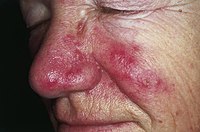
Photo from wikipedia
Purpose Rosacea is a chronic inflammatory dermatosis mainly involving facial skin, leading to physical and emotional problems, which greatly affect the quality of life (QoL) of patients. Dermatology Life Quality… Click to show full abstract
Purpose Rosacea is a chronic inflammatory dermatosis mainly involving facial skin, leading to physical and emotional problems, which greatly affect the quality of life (QoL) of patients. Dermatology Life Quality Index (DLQI) and willingness to pay (WTP) are well-established instruments assessing the health-related quality of life (HRQoL), while very few studies have been focused on this topic about rosacea in China. The present study investigated HRQoL in Chinese rosacea patients. Patients and Methods This cross-sectional study was conducted on 973 patients with rosacea. Sociodemographic data, clinical features and DLQI were collected, and WTP was assessed by three standardized items. Multivariable logistic analysis was performed to investigate independent factors influencing QoL. Results A total of 921 questionnaires were accomplished by participants. The mean DLQI score was 11.6 (median 11). Patients were willing to pay an average of € 896.2 (median € 368.1) for complete cure. 33.3% would like to pay more than 20% of their monthly income to achieve sustainable control. There were positive correlations between WTP with DLQI (P < 0.05). DLQI could be independently impacted by age (21–30 and 31–40 relative to > 50, OR = 3.242 and 3.617, respectively), the occupational requirement of appearance (high, OR = 4.410), disease duration (< 2 years, OR = 1.582), edema (OR = 1.844) and severity of flushing, burning, stinging and pruritus (severe, OR = 2.003, 1.981, 2.491, 2.249, respectively). There were no significant associations between WTP and most of the clinical factors. Conclusion The QoL was greatly impaired and should not be ignored among rosacea patients in China. Patients aged 21–40y, having occupational requirement of appearance, with the disease duration less than 2 years, and suffering severe flushing and related sensitive symptoms were more likely to have severe or very severe limitation of QoL.
Journal Title: Patient preference and adherence
Year Published: 2022
Link to full text (if available)
Share on Social Media: Sign Up to like & get
recommendations!